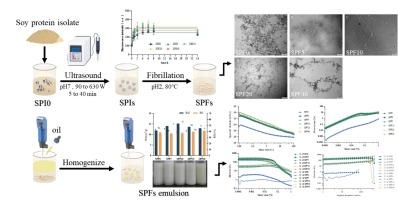Enhancement of physicochemical and techno-functional properties of soy protein isolate amyloid fibrils by moderate ultrasonic pretreatment
IF 8.7
1区 化学
Q1 ACOUSTICS
引用次数: 0
Abstract
Plant protein can be functionally strengthened by its modification into amyloid fibrils, which has drawn growing interest. In this study, we investigated the effects of ultrasonic pretreatment on the fibrillation kinetics, physicochemical properties, and functional aspects of soy protein isolate amyloid fibrils (SPF). Firstly, soy protein isolates (SPI) were subjected to ultrasonic pretreatment by regulating time and power under neutral conditions. Subsequently, the pretreated SPI was converted into SPF through acidic heating. The results indicated that ultrasonic pretreatment significantly improved surface hydrophobicity and solubility of SPI through ultrasound’s cavitation and thermal effects. Thioflavin T fluorescence assay revealed SPF40 (450 W, 40 min) had the fastest growth rate, 104.23 % higher than SPF0 (without ultrasonic pretreatment), while SPF10 (450 W, 10 min) had the highest fibril yield, 20.97 % higher than SPF0. Physicochemical analysis showed that ultrasonic pretreatment accelerated the formation of SPF from SPI by exposing the surface hydrophobic groups, lowering the zeta potential, breaking down original fibrils into shorter fibrils, and altering the secondary structure from α-helices into β-sheets. Morphological examination by transmission electron microscopy exhibited a higher maturation state, showing more rigid and straight fibrils structure in SPF10 compared to SPF0. Functionally, SPF with ultrasonic pretreatment had higher emulsifying activity than SPI and SPF0. Rheological analysis further confirmed SPF emulsions’ better mechanical strength over SPI emulsions. Overall, this study demonstrates that ultrasonic pretreatment is an effective way to enhance the formation and properties of SPF, which can be further applied to developing advanced protein products and novel functional food systems.

通过适度超声波预处理提高大豆分离蛋白淀粉样纤维的物理化学和技术功能特性。
植物蛋白可通过改性为淀粉样纤维来增强其功能,这引起了越来越多的关注。本研究探讨了超声波预处理对大豆分离蛋白淀粉样纤维(SPF)的纤维化动力学、理化性质和功能方面的影响。首先,在中性条件下通过调节时间和功率对大豆分离蛋白(SPI)进行超声波预处理。随后,通过酸性加热将预处理后的 SPI 转化为 SPF。结果表明,超声波预处理通过超声波的空化效应和热效应显著改善了 SPI 的表面疏水性和溶解性。硫黄素 T 荧光测定显示,SPF40(450 W,40 分钟)的生长速度最快,比 SPF0(未进行超声波预处理)高 104.23%,而 SPF10(450 W,10 分钟)的纤维产率最高,比 SPF0 高 20.97%。理化分析表明,超声波预处理通过暴露表面疏水基团、降低zeta电位、将原始纤维分解为更短的纤维以及改变二级结构(从α-螺旋变为β-片状),加速了SPI形成SPF。透射电子显微镜的形态学检查显示,与 SPF0 相比,SPF10 的成熟度更高,纤维结构更硬更直。在功能上,经过超声波预处理的 SPF 比 SPI 和 SPF0 具有更高的乳化活性。流变学分析进一步证实,与 SPI 乳液相比,SPF 乳液具有更好的机械强度。总之,本研究表明超声波预处理是提高 SPF 的形成和性能的有效方法,可进一步应用于开发高级蛋白质产品和新型功能性食品体系。
本文章由计算机程序翻译,如有差异,请以英文原文为准。
求助全文
约1分钟内获得全文
求助全文
来源期刊

Ultrasonics Sonochemistry
化学-化学综合
CiteScore
15.80
自引率
11.90%
发文量
361
审稿时长
59 days
期刊介绍:
Ultrasonics Sonochemistry stands as a premier international journal dedicated to the publication of high-quality research articles primarily focusing on chemical reactions and reactors induced by ultrasonic waves, known as sonochemistry. Beyond chemical reactions, the journal also welcomes contributions related to cavitation-induced events and processing, including sonoluminescence, and the transformation of materials on chemical, physical, and biological levels.
Since its inception in 1994, Ultrasonics Sonochemistry has consistently maintained a top ranking in the "Acoustics" category, reflecting its esteemed reputation in the field. The journal publishes exceptional papers covering various areas of ultrasonics and sonochemistry. Its contributions are highly regarded by both academia and industry stakeholders, demonstrating its relevance and impact in advancing research and innovation.
 求助内容:
求助内容: 应助结果提醒方式:
应助结果提醒方式:


